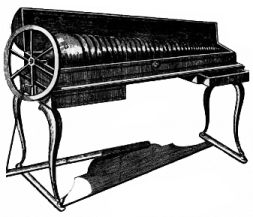Franklin's Glass Armonica

One of the special treats in our Franklin program is a rare chance to learn about and hear the glass armonica, an instument invented by Franklin in 1761. According to Wikipedia, "... 37 bowls were mounted horizontally nested on an iron spindle. The whole spindle turned by means of a foot-operated treadle. The sound was produced by touching the rims of the bowls with moistened fingers. Rims were painted different colors according to the pitch of the note....With the Franklin design it is possible to play ten glasses simultaneously if desired, a technique that is very difficult if not impossible to execute using upright goblets."

The instrument was very popular in the late 18th and early 19th century, with over 100 composers (including Mozart and Beethoven) writing music for it. Its popularity eventually faded, partly because of (unfounded) rumors that its ethereal tones could cause madness, but mainly because it was unsuited for performances in anything other than small chamber settings.
For a little historical background and some insight into how the instrument was made, check out this excellent five-minute segment from The History Channel (via YouTube). For a beautiful sample of how the instrument sounds, try this brief selection from YouTube.
There are a number of CDs featuring the glass armonica available on Amazon, including one by our featured lecturer/performer, Dennis James. Just go to Amazon using our link (we get a small cut of the purchase, at no cost to you), and do a search on "glass armonica".
What do you think of this strange instrument? Does it arouse any emotional reactions? Should it be revived?




